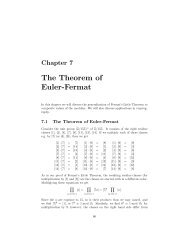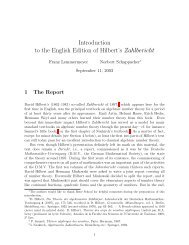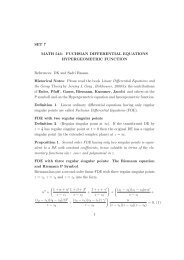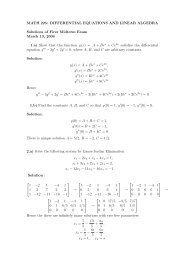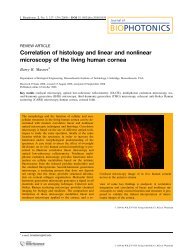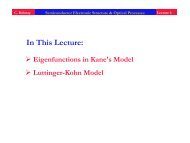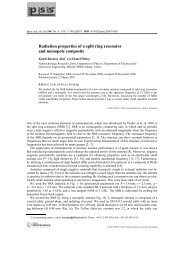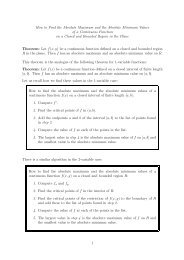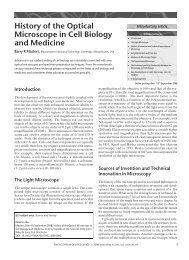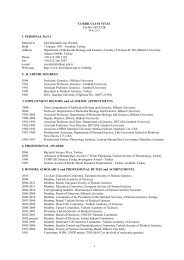Jump processes in surface diffusion - Bilkent University - Faculty of ...
Jump processes in surface diffusion - Bilkent University - Faculty of ...
Jump processes in surface diffusion - Bilkent University - Faculty of ...
You also want an ePaper? Increase the reach of your titles
YUMPU automatically turns print PDFs into web optimized ePapers that Google loves.
40 G. Antczak, G. Ehrlich / Surface Science Reports 62 (2007) 39–61<br />
Fig. 1. Hard-sphere models <strong>of</strong> bcc (a) (110), (b) (211), and (c) (321) planes.<br />
1.1. Surface diffusivities<br />
Diffusion is characterized by the material parameter D, the<br />
diffusivity <strong>in</strong> the (one-dimensional) <strong>diffusion</strong> equation:<br />
J = −D ∂c<br />
∂x<br />
connect<strong>in</strong>g the adatom flux J to the concentration gradient<br />
∂c/∂x. The diffusivity is given by the usual Arrhenius relation<br />
(<br />
D = D o exp − E )<br />
D<br />
, (2)<br />
kT<br />
where the prefactor D o , usually considered a constant, and<br />
the activation energy E D are obta<strong>in</strong>ed from the temperature<br />
dependence. Langmuir [1], <strong>in</strong> 1933, already viewed the atoms<br />
<strong>in</strong> <strong>surface</strong> <strong>diffusion</strong> as hopp<strong>in</strong>g between elementary spaces at a<br />
separation a, and was able to show that for an <strong>in</strong>dividual adatom<br />
the diffusivity was given <strong>in</strong> terms <strong>of</strong> the lifetime τ at a particular<br />
site by<br />
D = a 2 /2τ. (3)<br />
In transition-state theory the one-dimensional diffusivity is<br />
written more elaborately as:<br />
( ) (<br />
D = υl 2 SD<br />
exp exp − E )<br />
D<br />
, (4)<br />
k kT<br />
where υ gives the effective vibrational frequency <strong>of</strong> the adatom,<br />
l its jump length, and S D as well as E D the entropy and<br />
activation energy for <strong>diffusion</strong>. We can, however, <strong>in</strong>troduce the<br />
abbreviation:<br />
( )<br />
SD<br />
υ o = υ exp , (5)<br />
k<br />
so that the diffusivity appears as <strong>in</strong> Eq. (2), but with<br />
D o = υ o l 2 . (6)<br />
On <strong>surface</strong>s it would be difficult to measure atom fluxes<br />
and gradients. The mass flux <strong>of</strong> material over a <strong>surface</strong> can<br />
<strong>of</strong> course be detected, but it is not clear how to disentangle<br />
<strong>in</strong>teractions between the atoms. The diffusivity is therefore<br />
obta<strong>in</strong>ed alternatively from the E<strong>in</strong>ste<strong>in</strong> relation, which ties the<br />
diffusivity to the mean-square displacement 〈x 2 〉,<br />
〈x 2 〉 = 2Dt, (7)<br />
(1)<br />
Fig. 2. Models <strong>of</strong> fcc (a) (111) and (b) (100) planes.<br />
where t is the time <strong>in</strong>terval <strong>of</strong> the measurements.<br />
The elementary formalism is now <strong>in</strong> hand, and us<strong>in</strong>g it much<br />
data has been gathered about <strong>diffusion</strong> k<strong>in</strong>etics [2]. But what<br />
are the jump <strong>processes</strong> participat<strong>in</strong>g <strong>in</strong> <strong>surface</strong> <strong>diffusion</strong>? If<br />
atoms always jump between nearest-neighbour sites, then s<strong>in</strong>ce<br />
a typical vibrational frequency at the <strong>surface</strong> is ∼10 12 s −1 , and<br />
the spac<strong>in</strong>g is ∼3 Å, the prefactor D o should, if we neglect<br />
entropy contributions, be <strong>of</strong> magnitude ∼10 −3 cm 2 /s. It turns<br />
out that this is close to the value <strong>of</strong> the prefactor for many<br />
<strong>diffusion</strong> systems [2], start<strong>in</strong>g with one <strong>of</strong> the first studied, W<br />
on W(110), for which a value <strong>of</strong> 2.6×10 −3 cm 2 /s was found [3,<br />
4]. This agreement suggested that this simple view <strong>of</strong> <strong>diffusion</strong><br />
<strong>processes</strong> had considerable merit. However, the story has turned<br />
out to be much more <strong>in</strong>terest<strong>in</strong>g than that.<br />
2. Atom exchange<br />
2.1. On fcc(110) planes<br />
Early studies <strong>of</strong> <strong>in</strong>dividual metal atoms diffus<strong>in</strong>g on metals<br />
were with tungsten atoms on (110), (211), and (321) planes<br />
<strong>of</strong> bcc tungsten, models <strong>of</strong> which are shown <strong>in</strong> Fig. 1. Also<br />
studied somewhat later were rhodium atoms on rhodium, an fcc<br />
metal [4]. Exam<strong>in</strong>ed were (111) and (100), as well as (110),<br />
(311) and (331) planes, shown <strong>in</strong> Figs. 2 and 3. What is clear<br />
is that the (321) and (211) planes on tungsten and (311), (331)<br />
and (110) planes on rhodium are channelled, and that an adatom<br />
mov<strong>in</strong>g along one <strong>of</strong> these channels might be expected to stay <strong>in</strong><br />
such a channel and execute strictly one-dimensional <strong>diffusion</strong>.<br />
That was <strong>in</strong> fact found to be the case as shown <strong>in</strong> Fig. 4<br />
for W(211), mak<strong>in</strong>g predictions <strong>of</strong> the direction <strong>in</strong> <strong>diffusion</strong><br />
seem<strong>in</strong>gly straightforward.



